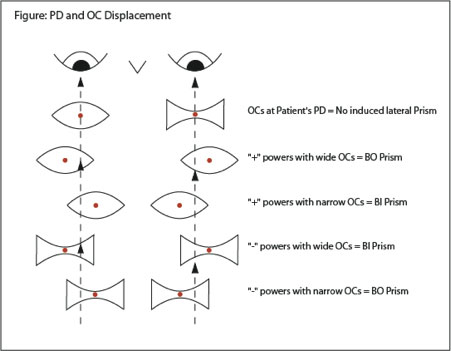- The power of the lens
- The distance of the point of entry from the optical axis (OC)
- The angle that the ray hits the lens surface
- Snell's Law
- The refractive index of the material
- The angle created when the ray exits the lens
Figure 1: OC location and the associated induced prism in lenses

Horizontal displacement of the OC results in Base In (BI), or Base Out (BO) prism. As a result, this illustrates why accurate PDs are essential; otherwise the patient looks through lateral prism. The correct centering of lenses avoids unwanted prism. Similarly, vertical displacement of the OC induces Base Up (BU), or Base Down (BD) prism. Specification of OC height insures the patient is looking through the OC correctly.

OC location and lens tilt, shifting the optical axis.
PRENTICE RULE
A convenient way to calculate prism is Prentice Rule:
Δ = F x d
Prism (Δ) = Lens Power (F) x Distance from the OC (cm) (d)
As the above equation shows, the amount of prism is directly proportional to lens power and the distance of the point of entry into the lens from the OC. Therefore, precise placement of the OC becomes increasingly more important as lens power increases.
Fig 2. Prism is affected by lens power and distance from the optical axis

Although OC displacement in either meridian has the potential to cause visual discomfort, this discussion is primarily concerned with the effects of unequal vertical powers in a patient's right and left lens prescriptions and the associated problems they can potentially create if preventative measures aren't taken by the optician.












